
A mango is an edible stone fruit produced by the tropical tree Mangifera indica. It originated from the region between northwestern Myanmar, Bangladesh, and northeastern India. M. indica has been cultivated in South and Southeast Asia since ancient times resulting in two types of modern mango cultivars: the "Indian type" and the "Southeast Asian type". Other species in the genus Mangifera also produce edible fruits that are also called "mangoes", the majority of which are found in the Malesian ecoregion.
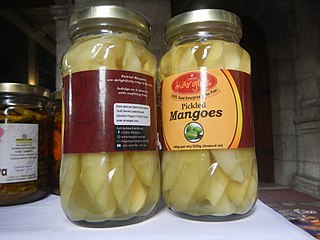
Burong mangga is a Filipino side dish and concoction made by mixing sugar, salt, and water to mangoes that have previously been salted. The mixture of water and sugar should be boiled and cooled first, before pouring it over the salted mangoes. Some variants add chilis to the cooled sugar water mixture. Original "basic" burong mangga is made using a brine solution and pouring it over halved unripe or partially ripe mangoes. Mango cultivars commonly used for burong mangga include 'Carabao' mangoes and 'Pico' mangoes.

The generic term for condiments in the Filipino cuisine is sawsawan. Unlike sauces in other Southeast Asian regions, most sawsawan are not prepared beforehand, but are assembled on the table according to the preferences of the diner.
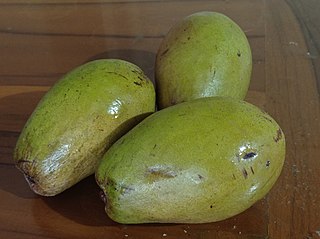
Mangifera caesia is a species of flowering plant in the cashew family, Anacardiaceae. Known in English as jack or white mango, among other names. It belongs to the same genus as the mango and is widely cultivated in areas of Indonesia, Malaysia, Singapore, Brunei, Papua New Guinea and the Philippines.

Turon (Tagalog pronunciation:[tuˈɾɔn]; also known as lumpiang saging or sagimis in dialectal Tagalog, is a Philippine snack made of thinly sliced bananas, rolled in a spring roll wrapper, fried till the wrapper is crisp and coated with caramelized brown sugar. Turon can also include other fillings. Most common is jackfruit, but there are also recipes with sweet potato , mango , cheddar cheese and coconut .
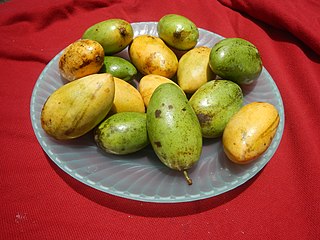
Mangifera altissima, is a species of mango native to the Philippines and surrounding regions in Indonesia, Malaysia, Papua New Guinea and the Solomon Islands. It is not grown commercially but is harvested from the wild in the Philippines. It has small fruits that are pale yellow when ripe and are very sweet, though much more fibrous than commercially cultivated Mangifera indica species like Carabao mangoes. It is threatened by habitat loss.

Mangifera odorata, commonly known as kwini, huani, or Saipan mango, is a species of plant with edible fruit in the family Anacardiaceae. It is similar to the related mango but is characterized by a strong turpentine-like smell on the skin and fibrous flesh. It is native to tropical Southeast Asia, but its exact original native range is unknown because it is only known from cultivated specimens and is believed to be a hybrid of Mangifera indica and Mangifera foetida. It is grown throughout Southeast Asia, from peninsular Thailand, to Malaysia, Indonesia and the southern Philippines. It has also been occasionally cultivated in southern Vietnam and the Marianas Islands.

Mangifera indica, commonly known as mango, is a species of flowering plant in the family Anacardiaceae. It is a large fruit tree, capable of growing to a height of 30 metres. There are two distinct genetic populations in modern mangoes – the "Indian type" and the "Southeast Asian type".

The 'Edward' mango is a named mango cultivar that originated in south Florida.
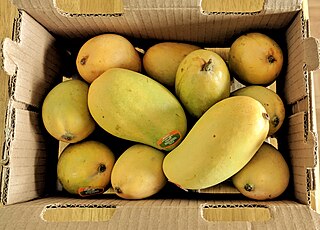
The 'Ataúlfo' mango is a mango cultivar from Mexico. Ataúlfo mangos are golden yellow and generally weigh between 6 and 10 ounces, with a somewhat sigmoid (oblong) shape and a gold-yellow skin. The flesh is not fibrous, and the pit is thin. They were named for grower Ataúlfo Morales Gordillo. Since August 27, 2003, the Ataúlfo mango is one of the 18 Mexican Designations of Origin.

The 'Cushman' mango is a mango cultivar that originated in south Florida. The variety had limited to no commercial application but has been sold as a dooryard tree.
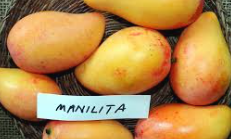
The 'Manilita' mango is a named mango cultivar that originated in Mexico.

Malgova' or Malgoa is an important mango cultivar mainly grown in Tamilnadu, Kerala and Karnataka and also in other parts of South India. It is a large round fruit, it has a small hard seed inside and is very juicy and fragrant. It is generally considered to be one of the best mangoes. Its production area is centred on the districts of Salem, Dharmapuri and Krishnagiri in Tamil Nadu, Gujarat, as well as neighbouring parts of Andhra Pradesh and Karnataka.

The Dinamulag Festival also known as the Zambales Mango Festival is an annual festival held in the province of Zambales in the Philippines to celebrate or encourage bountiful harvest of the province's mangoes. The festival was first held in 1999. The mascot is a mango.
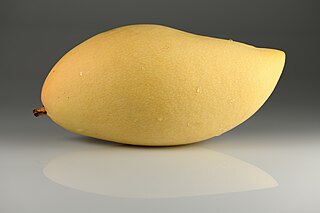
The Nam Dok Mai mango is a mango cultivar which originated in Thailand. It is the most popular mango variety in Thailand, and is grown commercially in Australia and Colombia as well, albeit as a minor variety.

Mango float or crema de mangga is a Filipino icebox cake dessert made with layers of ladyfingers (broas) or graham crackers, whipped cream, condensed milk, and ripe carabao mangoes. It is chilled for a few hours before serving, though it can also be frozen to give it an ice cream-like consistency. It is a modern variant of the traditional Filipino crema de fruta cake. It is also known by various other names like mango refrigerator cake, mango graham float, mango royale, and mango icebox cake, among others. Crema de mangga is another version that additionally uses custard and gulaman (agar) or gelatin, as in the original crema de fruta.

The Pico mango, also known as padero, is a variety of mango from the Philippines. Along with the Carabao mango, it is among the most commonly commercially cultivated mango cultivar in the Philippines.
Kiamoy, is a class of Filipino treats made with dried sour plums, prunes, or apricots preserved in brine and vinegar. They are sold covered in a powdery coating of an anise, li hing, salt, and sugar mixture called "kiamoy powder" or kiam-muy-hoon. They are characteristically bright red, orange, or light brown in color. They originate from Chinese Filipino immigrants and are derived from the li hing mui (旅行梅) treats of Chinese cuisine. The name is derived from Philippine Hokkien Chinese: 鹹梅; Pe̍h-ōe-jī: kiâm-muî; lit. 'salted plum'.

The Manggahan Festival is an annual month-long cultural, agricultural, and food festival held in the province of Guimaras, Philippines, every May. It is a celebration of the mango fruit, which the province is known for, emphasizes its significance in the local economy of the province alongside agriculture and tourism.




















